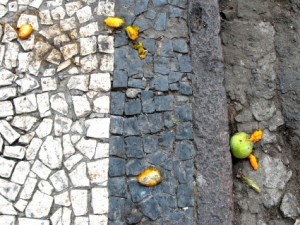
Photo © Michael Sommers.
In recent weeks, my father and mother (in Toronto) and my sister (in New York) have been stoking my sense of nostalgia (not to mention envy) with their rhapsodic descriptions of brightly colored leaves in shades of gold, saffron, and scarlet, swirling off branches and carpeting sidewalks, streets, and lawns.Okay fine, I retort, but in Bahia, where the leaves stay green and on the trees year round, the mangos have been falling.
As in many Brazilian cities, the streets of Salvador’s neighborhoods are lined with lofty, dark, shade-giving mangueiras (mango trees), some of them quite old. Most of the time, walking around, you don’t pay them much heed. However, come October, you suddenly notice that the once imperceptible green oblong fruits have taken on rich sunset hues. As enticing as they appear, like great clusters of dangling jewels, you mustn’t keep your gaze trained solely on the branches. If you do so you’ll risk missing the ripe fruit that has plopped on the sidewalks and streets, its pungent yellow flesh oozing out of the wounded skin.
I always thought of falling mangos as more delightfully exotic than hazardous until the time I slipped on one.I always thought of falling mangos as more delightfully exotic than hazardous until the time I slipped on one. A sudden wet whoosh beneath the sole of my shoe, and I instantly found myself completely horizontal on the sidewalk, my thigh bruised and my freshly washed and ironed white trousers completely soiled with mango pulp. As it happened, I was on the way to a somewhat fancy vernissage and the wipe-out occurred when I was only a block away from the art gallery.
After gingerly picking myself up and inspecting the damage (physical and sartorial), I debated whether or not I should continue to the vernissage or go home and soak my pants (and my head). Deciding it would be foolish to let a mere fruit get the better of me, I resolved to make my way to the gallery. Upon my arrival, I grabbed a giant glass of whiskey and made a beeline for the bathroom where with water, soap, and paper towels, I tried to do some damage control. After that night, I was never again able to walk with such carefree abandon during mango season.
* * *
Although mangos are ubiquitous throughout tropical Brazil, they’re not native to the country. The first seedlings were brought to Bahia in the early 1700s by Portuguese colonists who had happened upon them in India. Subsequently, Brazil became the first nation in the Americas to cultivate mangos. Today the country produces 825,000 tons of mangos yearly – 90 percent of which are gobbled up by Brazilians themselves. Even so, the remaining 67,000 tons that are exported are enough to make Brazil the second largest mango exporter in the world (after Mexico).
Mangueiras (mango trees) can live up to the ripe old age of 300. In Rio de Janeiro, those that once covered the hills facing the imperial palace of Quinta da Boa Vista were so abundant that they gave their name to the neighborhood of Mangueira and its famous samba school, Estação Primeira da Mangueira, whose emblematic colors are those of its namesake fruit; green and pink.
At the other end of the country, Belém, capital of the Amazonian state of Pará, is known as the “Cidade das Mangueiras” (“City of Mango Trees”) due to the thousands that were planted to adorn its central streets and squares in the mid-19th century. Today, they are so profuse that they create veritable tunnels, which offer delicious shade from the baking sun. However, when it rains in Belém, instead of cats and dogs, it often pours mangos – a fact that inspired the local expression “levar uma doida mangada” (which translates roughly into “getting hit with a crazy mango” or, better yet, “getting crazily mangoed”).
It’s common in Belém to see locals – and not just street people – gathering mangos after a storm. The city even boasts professional apanhadores de manga (“mango catchers”) who, with the flair of a lasso throwing John Wayne, toss ropes up into the branches and proceed to shake clusters of ripe fruit down into waiting baskets and buckets (an activity appreciated by car owners since it diminishes the chances of having their roofs dented or windshields cracked by an errant fruit).
Brazilians don’t mess around with mangos. You won’t run into any mango cakes, tortes, cookies or crumbles. Aside from ice cream, most Brazilians prefer their mangos liquefied to a refreshing juice form or straight up. Depending on the variety (there are hundreds in Brazil, around a dozen of which are fairly common) and the ripeness, they are peeled and sliced into bite-sized pieces, eaten with a spoon, or devoured as is. The latter method is known as “chupando uma manga” (“sucking a mango”) and is both a sensuous and messy process; although you’ll have sticky juice trickling down your arms and chin and fibers stuck between your teeth, in terms of pure pleasure it ranks up there with shuffling through a pile of fragrant autumn leaves.